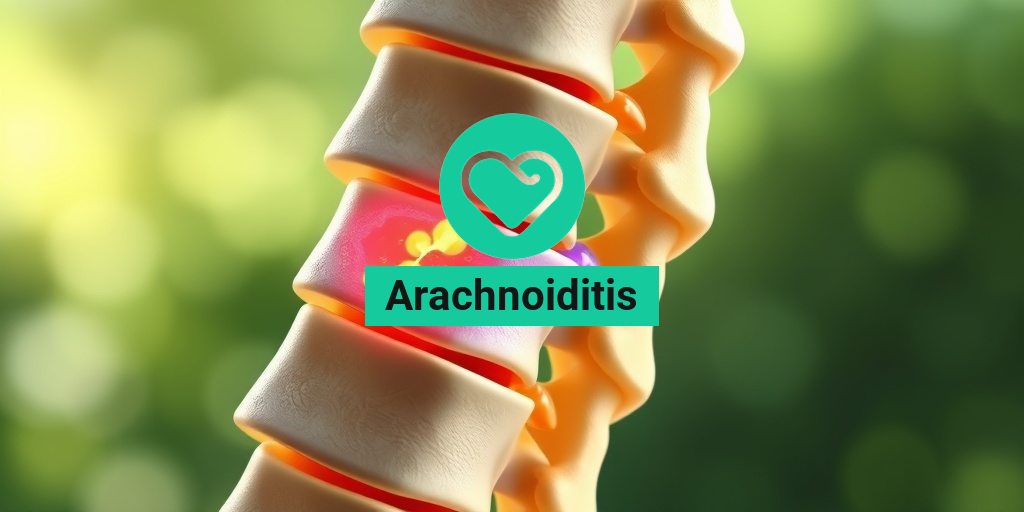What Is Arachnoiditis?
Arachnoiditis is a rare but serious condition that affects the arachnoid mater, one of the three membranes that surround the brain and spinal cord. This inflammation can lead to a variety of neurological symptoms and complications, making it a significant concern for those affected. Understanding the nature of this condition is crucial for early diagnosis and effective management.
Understanding the Arachnoid Mater
The arachnoid mater is a delicate membrane situated between the outer dura mater and the inner pia mater. It plays a vital role in protecting the central nervous system (CNS) and maintaining the cerebrospinal fluid (CSF) environment. When inflammation occurs, it can disrupt the normal functioning of the CNS, leading to various symptoms.
Causes of Arachnoiditis
Arachnoiditis can be triggered by several factors, including:
- Infections: Bacterial or viral infections can lead to inflammation of the arachnoid mater.
- Spinal Procedures: Surgical interventions, lumbar punctures, or epidural injections can sometimes cause irritation and inflammation.
- Trauma: Physical injury to the spine can also result in arachnoiditis.
- Chronic Conditions: Conditions like multiple sclerosis or other autoimmune disorders may contribute to the development of arachnoiditis.
Types of Arachnoiditis
There are different types of arachnoiditis, with the most common being:
- Arachnoiditis Ossificans: This type involves the formation of bone-like tissue in the arachnoid layer, often leading to more severe symptoms.
- Post-Surgical Arachnoiditis: This occurs after spinal surgery, where scar tissue forms and causes inflammation.
Arachnoiditis Symptoms
The symptoms of arachnoiditis can vary widely among individuals, depending on the severity of the inflammation and the areas affected. Common symptoms include:
Chronic Pain
One of the hallmark symptoms of arachnoiditis is chronic pain, which can be debilitating. This pain often manifests in the lower back and can radiate down the legs, resembling sciatica. Patients may describe the pain as burning, stabbing, or aching.
Nerve Dysfunction
Arachnoiditis can lead to nerve dysfunction, resulting in:
- Numbness: Affected individuals may experience numbness or tingling sensations in their limbs.
- Weakness: Muscle weakness can occur, making it difficult to perform everyday tasks.
- Coordination Issues: Some may struggle with balance and coordination due to nerve involvement.
Other Neurological Symptoms
In addition to pain and nerve dysfunction, other symptoms may include:
- Bladder and Bowel Dysfunction: Arachnoiditis can affect the nerves controlling bladder and bowel functions, leading to incontinence or difficulty urinating.
- Sexual Dysfunction: Some individuals may experience sexual dysfunction due to nerve involvement.
- Psychological Symptoms: Chronic pain and disability can lead to anxiety, depression, and other psychological issues.
When to Seek Medical Attention
If you experience persistent pain, numbness, or any of the symptoms mentioned above, it is essential to consult a healthcare professional. Early diagnosis and intervention can significantly improve outcomes for those with arachnoiditis.
For those seeking more information about arachnoiditis and its management, Yesil Health AI (yesilhealth.com) offers evidence-based health answers that can guide you through understanding this complex condition.
In conclusion, while arachnoiditis can be a challenging condition to navigate, awareness of its symptoms and causes can empower individuals to seek timely medical care. Remember, you are not alone in this journey, and there is hope for managing your symptoms effectively. 🌟

Arachnoiditis Causes
Arachnoiditis is a painful condition that affects the arachnoid, one of the three membranes that surround the brain and spinal cord. Understanding the causes of arachnoiditis is crucial for effective management and treatment. Here are some of the primary causes:
1. Spinal Procedures
One of the most common causes of arachnoiditis is related to spinal procedures. These include:
- Spinal taps (lumbar punctures) – This procedure can introduce irritants into the arachnoid space.
- Spinal surgeries – Operations on the spine can lead to inflammation and scarring.
- Injections – Epidural steroid injections, while often used for pain relief, can sometimes trigger arachnoiditis.
2. Infections
Infections can also lead to arachnoiditis. Conditions such as:
- Bacterial meningitis – This serious infection can cause inflammation of the arachnoid layer.
- Viral infections – Certain viruses can also contribute to the development of this condition.
3. Chemical Irritants
Chemical irritants, such as those found in certain medications or contrast dyes used in imaging studies, can provoke an inflammatory response in the arachnoid. This can lead to chronic pain and discomfort.
4. Trauma
Physical trauma to the spine, such as from accidents or falls, can damage the arachnoid and lead to arachnoiditis. The resulting inflammation can cause significant pain and neurological symptoms.
5. Other Medical Conditions
Some underlying medical conditions may predispose individuals to arachnoiditis. These include:
- Autoimmune disorders – Conditions like lupus or multiple sclerosis can increase inflammation.
- Previous spinal injuries – A history of spinal injuries can heighten the risk.
Arachnoiditis Risk Factors
Identifying the risk factors for arachnoiditis can help in early detection and prevention. Here are some key factors to consider:
1. Previous Spinal Procedures
Individuals who have undergone spinal surgeries or procedures are at a higher risk of developing arachnoiditis. The more invasive the procedure, the greater the risk of complications.
2. Age
Age can play a significant role in the likelihood of developing arachnoiditis. Older adults may have a higher risk due to degenerative changes in the spine and increased likelihood of previous medical interventions.
3. Gender
Research suggests that women may be more susceptible to arachnoiditis than men. Hormonal differences and variations in pain perception could contribute to this disparity.
4. History of Infections
Individuals with a history of infections, particularly those affecting the central nervous system, are at an increased risk. This includes previous episodes of meningitis or other neurological infections.
5. Genetic Predisposition
Some studies indicate that genetic factors may influence the likelihood of developing arachnoiditis. If there is a family history of autoimmune diseases or spinal conditions, the risk may be elevated.
6. Lifestyle Factors
Certain lifestyle choices can also impact the risk of arachnoiditis. Factors such as:
- Smoking – This can contribute to overall spinal health deterioration.
- Obesity – Excess weight can put additional strain on the spine.
Understanding the causes and risk factors of arachnoiditis is essential for those who may be affected by this condition. By being aware of these elements, individuals can take proactive steps towards prevention and seek timely medical advice when necessary. 🌟

Arachnoiditis Diagnosis
Arachnoiditis is a painful and often debilitating condition that affects the arachnoid membrane, one of the three layers of tissue that cover the brain and spinal cord. Diagnosing this condition can be challenging due to its complex nature and the overlap of symptoms with other conditions. Here, we’ll explore the various methods used to diagnose arachnoiditis.
Understanding Symptoms
The first step in diagnosing arachnoiditis is recognizing its symptoms. Patients often report:
- Chronic pain: This can be localized or widespread, often described as burning or stabbing.
- Nerve dysfunction: Symptoms may include numbness, tingling, or weakness in the limbs.
- Muscle spasms: Involuntary contractions can occur, leading to discomfort.
- Bladder and bowel issues: Some patients experience difficulties with urinary control or constipation.
Because these symptoms can mimic other conditions, a thorough medical history and physical examination are crucial for an accurate diagnosis.
Imaging Techniques
Once a healthcare provider suspects arachnoiditis, imaging studies are typically ordered to confirm the diagnosis. The most common imaging techniques include:
- Magnetic Resonance Imaging (MRI): This is the gold standard for diagnosing arachnoiditis. MRI can reveal inflammation of the arachnoid membrane and any associated changes in the spinal cord.
- Computed Tomography (CT) Scan: While less commonly used than MRI, a CT scan can help visualize the spine and detect any abnormalities.
These imaging techniques allow doctors to assess the extent of the condition and rule out other potential causes of the symptoms.
Additional Diagnostic Tests
In some cases, additional tests may be necessary to confirm the diagnosis of arachnoiditis:
- Lumbar Puncture (Spinal Tap): This procedure can help analyze cerebrospinal fluid (CSF) for signs of inflammation or infection.
- Electromyography (EMG): This test measures the electrical activity of muscles and can help determine if nerve damage is present.
Consulting with a specialist, such as a neurologist or pain management expert, can also provide valuable insights into the diagnosis and management of arachnoiditis.
Arachnoiditis Treatment Options
Once diagnosed, managing arachnoiditis can be a complex process. Treatment options vary based on the severity of symptoms and the individual patient’s needs. Here, we’ll discuss some of the most common approaches to treating arachnoiditis.
Medications
Medications are often the first line of defense against the pain and discomfort associated with arachnoiditis. Commonly prescribed medications include:
- Nonsteroidal Anti-Inflammatory Drugs (NSAIDs): These can help reduce inflammation and alleviate pain.
- Antidepressants: Certain antidepressants can be effective in managing chronic pain.
- Anticonvulsants: Medications like gabapentin may help relieve nerve pain.
- Opioids: In severe cases, stronger pain relief may be necessary, but these should be used cautiously due to the risk of dependency.
Physical Therapy
Physical therapy can play a crucial role in the treatment of arachnoiditis. A physical therapist can design a personalized exercise program to:
- Improve mobility and flexibility
- Strengthen muscles
- Reduce pain through targeted exercises
Engaging in regular physical activity can also help improve overall well-being and reduce the impact of chronic pain.
Alternative Therapies
Many patients find relief through alternative therapies, which can complement traditional treatments. Some popular options include:
- Acupuncture: This ancient practice may help alleviate pain and improve function.
- Chiropractic Care: Some patients benefit from spinal manipulation and adjustments.
- Massage Therapy: Therapeutic massage can help reduce muscle tension and improve circulation.
It’s essential to discuss any alternative therapies with your healthcare provider to ensure they are safe and appropriate for your condition.
Surgical Options
In rare cases, surgery may be considered for patients with severe arachnoiditis that does not respond to conservative treatments. Surgical options may include:
- Decompression Surgery: This procedure aims to relieve pressure on the spinal cord or nerves.
- Spinal Fusion: In cases of instability, spinal fusion may be performed to stabilize the spine.
However, surgery carries risks and should only be considered after careful evaluation by a specialist.
In conclusion, while the journey to diagnose and treat arachnoiditis can be challenging, a combination of medical intervention, physical therapy, and alternative treatments can help manage symptoms and improve quality of life. 🌟

Arachnoiditis Management Strategies
Arachnoiditis is a painful and often debilitating condition that affects the arachnoid membrane, one of the protective layers surrounding the spinal cord and brain. Managing this condition requires a comprehensive approach tailored to the individual’s symptoms and needs. Here are some effective management strategies:
1. Pain Management
Pain is one of the most challenging symptoms of arachnoiditis. Effective pain management is crucial for improving quality of life. Here are some common methods:
- Medications: Over-the-counter pain relievers like ibuprofen or acetaminophen can help. In more severe cases, prescription medications such as opioids or nerve pain medications like gabapentin may be necessary.
- Physical Therapy: Engaging in physical therapy can help strengthen muscles and improve mobility, which may alleviate some pain associated with arachnoiditis.
- Alternative Therapies: Techniques such as acupuncture, chiropractic care, and massage therapy can provide relief for some individuals.
2. Lifestyle Modifications
Making certain lifestyle changes can significantly impact the management of arachnoiditis:
- Regular Exercise: Low-impact exercises, such as swimming or walking, can help maintain mobility and reduce stiffness.
- Healthy Diet: A balanced diet rich in anti-inflammatory foods can support overall health and potentially reduce pain levels.
- Stress Management: Techniques such as yoga, meditation, and deep-breathing exercises can help manage stress, which may exacerbate pain.
3. Medical Interventions
In some cases, more invasive treatments may be necessary:
- Injections: Corticosteroid injections can help reduce inflammation and provide temporary relief from pain.
- Surgery: While surgery is not common, it may be considered in severe cases where other treatments have failed. Procedures may involve decompression or removal of scar tissue.
4. Support Systems
Living with arachnoiditis can be isolating, but support systems can make a significant difference:
- Support Groups: Connecting with others who have arachnoiditis can provide emotional support and practical advice.
- Professional Counseling: Speaking with a mental health professional can help individuals cope with the emotional toll of chronic pain.
Arachnoiditis Prognosis
The prognosis for individuals with arachnoiditis can vary widely based on several factors, including the severity of the condition, the underlying cause, and the effectiveness of management strategies. Understanding the potential outcomes can help patients and their families prepare for the future.
1. Chronic Pain and Disability
Many individuals with arachnoiditis experience chronic pain, which can lead to significant disability. The pain may fluctuate in intensity, and while some may find relief through various treatments, others may continue to struggle with persistent symptoms. It’s essential to have realistic expectations and to work closely with healthcare providers to manage pain effectively.
2. Impact on Daily Life
Arachnoiditis can affect daily activities, including work, social interactions, and self-care. Many individuals may need to make adjustments to their lifestyle, such as:
- Work Modifications: Some may need to change their work environment or reduce hours to accommodate their symptoms.
- Assistance with Daily Tasks: Depending on the severity of symptoms, individuals may require help with daily activities, which can impact their independence.
3. Emotional and Psychological Effects
The chronic nature of arachnoiditis can lead to emotional challenges, including anxiety and depression. It’s crucial for individuals to seek support and consider counseling or therapy as part of their overall management plan. Building a strong support network can also help mitigate these emotional effects.
4. Long-Term Outlook
While there is currently no cure for arachnoiditis, many individuals find ways to manage their symptoms effectively. With the right combination of treatments and support, some may experience periods of remission or reduced symptoms. Staying informed about the condition and actively participating in management strategies can empower individuals to lead fulfilling lives despite the challenges of arachnoiditis.
In conclusion, understanding the management strategies and prognosis of arachnoiditis is essential for those affected by this condition. By taking a proactive approach, individuals can navigate their journey with greater confidence and hope. 🌟

Frequently Asked Questions about Arachnoiditis
What is Arachnoiditis?
Arachnoiditis is a painful condition caused by inflammation of the arachnoid, one of the membranes surrounding the brain and spinal cord. This inflammation can lead to severe pain, neurological issues, and other complications.
What are the symptoms of Arachnoiditis?
- Chronic pain in the back or legs
- Numbness or tingling sensations
- Muscle weakness
- Bladder and bowel dysfunction
- Difficulty walking
How is Arachnoiditis diagnosed?
Diagnosis typically involves a combination of medical history, physical examination, and imaging tests such as MRI or CT scans to assess the condition of the spinal cord and surrounding tissues.
What are the treatment options for Arachnoiditis?
Treatment for arachnoiditis focuses on managing symptoms and may include:
- Medications for pain relief
- Physical therapy
- Injections for inflammation
- Surgery in severe cases
Can Arachnoiditis be cured?
Currently, there is no known cure for arachnoiditis. However, many patients find relief through various treatment options and lifestyle adjustments.
Is there a specialist for Arachnoiditis?
If you are seeking help for arachnoiditis, it is advisable to consult with a specialist such as a neurologist or a pain management expert. You can search for an arachnoiditis specialist near you for personalized care.
What is Arachnoiditis Ossificans?
Arachnoiditis ossificans is a rare form of the condition where bone forms in the arachnoid layer, leading to additional complications. It requires specialized treatment and management.
How does Arachnoiditis affect the lumbar spine?
Arachnoiditis can significantly impact the lumbar spine, leading to chronic pain and mobility issues. Treatment often focuses on alleviating these symptoms to improve quality of life.
Where can I find support for Arachnoiditis?
Many organizations and online communities offer support for individuals dealing with arachnoiditis. Connecting with others who understand your experience can provide hope and encouragement. 🌟
How is Arachnoiditis pronounced?
The pronunciation of arachnoiditis is “uh-rak-noid-eye-tis.” If you need further assistance with pronunciation, many online resources can help.
What is the ICD-10 code for Arachnoiditis?
The ICD-10 code for arachnoiditis is G03.9. This code is used for billing and insurance purposes when diagnosing the condition.




